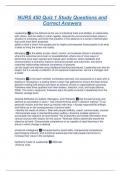NURS 450 Quiz 1 Study Questions and
Correct Answers
Leadership ✅can be defined as the use of individual traits and abilities, in relationship
with others, and the ability to (often rapidly) interpret the environment/context where a
situation is emerging, and enter that situation in the absence of a script or defined plan
that could have been projected.
ability to elicit a vision from people and to inspire and empower those people to do what
it takes to bring the vision into reality.
Managing ✅is the ability to plan, direct, control, and evaluate others in situations
where the outcomes are known or preestablished, where one of more ways of
performing have been agreed upon based upon evidence, where feedback and
communication is shared to improve clinical processes and outcomes, and where
sustained relationships advance consistency of purpose.
can be taught and learned using traditional teaching techniques. Leadership can also be
taught, but it is usually a reflection of rich personal experiences. can be a manager and
a leader
Followers ✅is that each member contributes optimally, but acquiesces to a peer who is
leading or managing in a setting where a team has gathered to ensure the best clinical
decision-making and actions are taken to achieve clinical or organizational outcomes.
Followers need three qualities from their leaders: direction, trust, and hope (Bennis,
2009). The trust is reciprocal. Followers learn the skills involved in leadership from the
follower vantage point.
Desired Attributes of Leaders, Managers, and Followers ✅Use focused energy and
stamina to accomplish a vision • Use critical-thinking skills in decision making • Trust
personal intuition and then back up intuition with facts • Accept responsibility willingly
and follow up on the consequences of actions taken
• Identify the needs of others • Deal with people skillfully: coach, communicate, counsel
• Demonstrate ease in standard/boundary setting • Examine multiple options to
accomplish the objective at hand flexibly • Be trustworthy and handle information from
various sources with respect for the source • Motivate others assertively toward the
objective at hand • Demonstrate competence or be capable of rapid learning in the
arena in which change is desired
emotional intelligence ✅characterized by social skills, interpersonal competence,
psychological maturity, and emotional awareness that help people harmonize to
increase their value in the workplace.
Gardner's Tasks of Leadership ✅-Motivate
-Achieve Unity
,-Develop Trust
-Envision Goal
-Symbol
-Affirm Values
-Manage
-Explain
-Represent Group
-Renew
Transactional Leadership ✅environment, employees understand that a superior makes
the decisions with little or no input from subordinates. Transactional leadership relies on
the power of organizational position and formal authority to reward and punish
performance.
-quid pro style (do x in exchange for y)
Leadership development ✅Leadership effectiveness depends on mastering the art of
persuasion and communication.
1. Select a mentor. 2. Lead by example. 3. Accept responsibility. 4. Share the rewards.
5. Have a clear vision. 6. Be willing to grow.
Surviving and Thriving as a Leader ✅1. Maintain balance. 2. Generate self-motivation.
3. Build self-confidence. 4. Listen to constituents. 5. Maintain a positive attitude.
Definition of Management ✅Management is a generic function that includes focusing
on completing the work that must be done, address complex issues by organizing,
planning, budgeting, and setting target goals. They meet their goals by organizing,
staffing, controlling, and solving problems.
Leader, Manager, and Follower Traits ✅Leader-Values commitments, relationships
with others,
Manager-Emphasizes organizing, coordinating, and controlling
Follower-Perceives the needs of both the leader and other staff
Delegation ✅always involves at least two individuals (delegator and delegatee) who
engage in open communication to achieve a goal.
delegators ✅are registered nurses who allocate a portion of work related to patient
care to another individual.
delagatees ✅are often comprised of UNPs, often called assistants, technicians, patient
care associates, or aides.
responsibility ✅refers to the reliability, dependability and obligation to accomplish work.
, authority ✅is the ability to perform duties in a specific role.
5 rights of delegation ✅1. Right task
2. Right circumstance
3. Right person
4. Right direction/communication
5. Right supervision/evaluation
role transitions ✅involves transforming one's professional identity. A new graduate
makes a transition from the student role to the nurse role. Expectations of students are
clearly specified in course and clinical objectives.
ROLES ✅R-responsibilities O-opportunities L-lines of communication E-expectations
Support
Role preview ✅Both parties present their best characteristics and dedicate much
energy to developing the relationship.
Role Acceptance ✅In role transition, the formal commitment of the employment
contract implies acceptance of the management role, or "role acceptance."
role exploration ✅honeymoon phase, The new graduate may be relieved that the
educational program was successfully completed and now a salary can be earned.
role discrepancy ✅a gap between role expectations and role performance, Role
discrepancy can be resolved by either dissolving the relationship or by changing
expectations and performance.
role development ✅choosing to change role expectations and/or role performance
role internalization ✅stage at which a person has learned behaviors that maintain a
role so thoroughly that the person performs them without consciously considering them;
energy once spent on establishing these behaviors can be redirected to other goals
unexpected role transition ✅When a relationship ends unexpectedly, a person goes
through a grieving process. In a similar way, when a person is fired, a position is
eliminated, or a job description changes dramatically, the person may have to grieve
before being able to engage in role transition.
Delegation: An Art and Skill of Professional Nursing Practice ✅A multifaceted decision-
making strategy
Implemented to improve the work performance of staff in the healthcare organization
Implemented to achieve nursing goals and improve patient care outcomes




